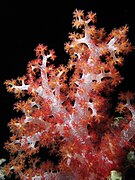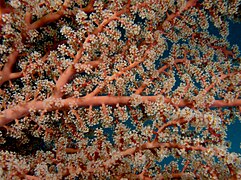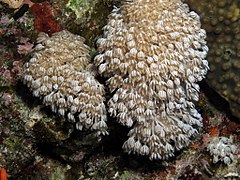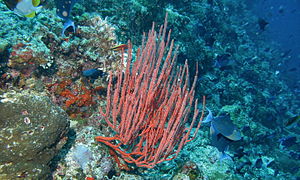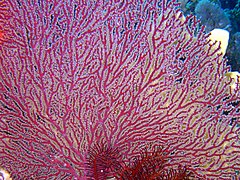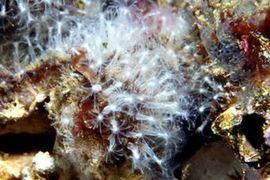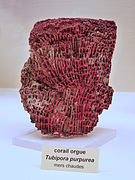Alcyonacea
| Soft coral | |
|---|---|

| |
| Cladiella sp. | |
| Scientific classification | |
| Domain: | Eukaryota |
| Kingdom: | Animalia |
| Phylum: | Cnidaria |
| Class: | Octocorallia |
| Order: | Alcyonacea Lamouroux, 1812 [1] |
| Suborders | |
|
See text | |
| Synonyms | |
| |
Alcyonacea are an order of sessile colonial
About 500 different species of gorgonians are found in the oceans of the world, but they are particularly abundant in the shallow waters of the Western Atlantic, including Florida, Bermuda, and the West Indies.[5]
Anatomy


The structure of a gorgonian colony varies. In the suborder Holaxonia, skeletons are formed from a flexible, horny substance called gorgonin. The suborder Scleraxonia species are supported by a skeleton of tightly grouped calcareous spicules. Also, some species encrust like coral.[6]
Measurements of the gorgonin and calcite within several long-lived species of gorgonians can be useful in paleoclimatology and paleoceanography, as their skeletal growth rate and composition are highly correlated with seasonal and climatic variation.[7][8][9]
Features
Soft corals contain minute, spiny skeletal elements called sclerites, useful in species identification. Sclerites give these corals some degree of support and give their flesh a spiky, grainy texture that deters predators. In the past, soft corals were thought to be unable to lay new foundations for future corals, but recent findings suggest that colonies of the leather-coral genus Sinularia are able to cement sclerites and consolidate them at their base into alcyonarian spiculite,[10] thus making them reef builders.
Unlike
Despite being dominated by "soft corals", the order Alcyonacea now contains all species known as "gorgonian corals", that produce a hard skeleton made from gorgonin, a protein unique to the group that makes their skeletons quite different from "true" corals (Scleractinia). These "gorgonion corals" can be found in suborders Holaxonia, Scleraxonia, and Stolonifera.
Many soft corals are easily collected in the wild for the reef aquarium hobby, as small cuttings are less prone to infection or damage during shipping than stony corals. Nevertheless, home-grown specimens tend to be more adaptable to aquarium life and help conserve wild reefs. Soft corals grow quickly in captivity and are easily divided into new individuals, and so those grown by aquaculture are often hardier and less expensive than imported corals from the wild.
Ecology

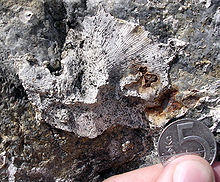
Each gorgonian polyp has eight
Some gorgonians contain algae, or
Gorgonians are found primarily in shallow waters, though some have been found at depths of several thousand feet.[4][6] The size, shape, and appearance of gorgonians can be correlated with their location. The more fan-shaped and flexible gorgonians tend to populate shallower areas with strong currents, while the taller, thinner, and stiffer gorgonians can be found in deeper, calmer waters.[4]
Other fauna, such as
Gorgonians produce unusual
Suborders and families
The World Register of Marine Species lists these suborders and families:[18]
- suborder Alcyoniina
- family Acrophytidae McFadden & Ofwegen, 2017
- family Alcyoniidae Lamouroux, 1812
- family AquaumbridaeBreedy, van Ofwegen & Vargas, 2012
- family CorymbophytidaeMcFadden & Ofwegen, 2017
- family Leptophytidae McFadden & Ofwegen, 2017
- family Nephtheidae Gray, 1862
- family Nidaliidae Gray, 1869
- family Paralcyoniidae Gray, 1869
- family Xeniidae Ehrenberg, 1828
- suborder Calcaxonia
- family Chrysogorgiidae Verrill, 1883
- family Ellisellidae Gray, 1859
- family Ifalukellidae Bayer, 1955
- family IsididaeLamouroux, 1812
- family Primnoidae Milne Edwards, 1857
- suborder Holaxonia
- family Acanthogorgiidae Gray, 1859
- family Dendrobrachiidae Brook, 1889
- family Gorgoniidae Lamouroux, 1812
- family Keroeididae Kinoshita, 1910
- family Plexauridae Gray, 1859
- suborder Protoalcyonaria
- family TaiaroidaeBayer & Muzik, 1976
- family
- suborder Scleraxonia
- family Anthothelidae Broch, 1916
- family Briareidae Gray, 1859
- family Coralliidae Lamouroux, 1812
- family Melithaeidae Gray, 1870
- family Paragorgiidae Kükenthal, 1916
- family ParisididaeAurivillius, 1931
- family Spongiodermidae Wright & Studer, 1889
- family Subergorgiidae Gray, 1859
- family VictorgorgiidaeMoore, Alderslade & Miller, 2017
- suborder Stolonifera
- family AcrossotidaeBourne, 1914
- family Arulidae McFadden & van Ofwegen, 2012
- family Clavulariidae Hickson, 1894
- family CoelogorgiidaeBourne, 1900
- family Cornulariidae Dana, 1846
- family PseudogorgiidaeUtinomi & Harada, 1973
- family TubiporidaeEhrenberg, 1828
- family
- family Acanthoaxiidaevan Ofwegen & McFadden, 2010
- family Haimeidae Wright, 1865
- family Paramuriceidae Bayer, 1956
- family ParasphaerascleridaeMcFadden & van Ofwegen, 2013
- family Viguieriotidae
-
Alcyonium acaule, an alcyoniid
-
Dendronephthya hemprichi, a nephtheid
-
Siphonogorgia godeffroyi, a nidaliid
-
Maasella edwardsi, a paralcyoniid
-
Heteroxenia fuscescens, a xeniid
-
Iridigorgia sp., a chrysogorgiid
-
Ellisella sp., an ellisellid
-
Isidella tentaculum, an isidid
-
Plumarella pellucida, a primnoid
-
Muricella sp., an acanthogorgiid
-
Gorgonia ventalina, a gorgoniid
-
Paramuricea clavata, a paramuriceid
-
Muricea elongata, a plexaurid
-
Anthothela grandiflora, an anthothelid
-
Briareum sp., a briareid
-
Corallium rubrum, a coralliid
-
Acabariasplendens, a melithaeid
-
Paragorgia arborea, a paragorgiid
-
Annella mollis, a subergorgiid
-
Clavularia viridis, a clavulariid
-
Cornularia cornucopiae, a cornulariid
-
Tubipora musica, Tubiporidae
References
- ^ van Ofwegen, L. (2011). "Alcyonacea Lamouroux, 1812". WoRMS. World Register of Marine Species. Retrieved 15 December 2011.
- ^ Bayer, F. M. (1961). The shallow-water Octocorallia of the West Indian region. Studies on the Fauna of Curaçao and other Caribbean Islands, 12(1), 1-373.; Córdova-Isaza, A., Jiménez-Mármol, S., Guerra, Y., & Salas-Sarduy, E. (2023). Enzyme Inhibitors from Gorgonians and Soft Corals. Marine Drugs, 21(2), 104. https://doi.org/10.3390/md21020104; Raimundo, I., Silva, S., Costa, R., & Keller-Costa, T. (2018). Bioactive Secondary Metabolites from Octocoral-Associated Microbes—New Chances for Blue Growth. Marine Drugs, 16(12), 485. https://doi.org/10.3390/md16120485
- ^ Daly, M., M.R. Brugler, P. Cartwright, A.G. Collins, M.N. Dawson, D.G. Fautin, S.C. France, C.S. McFadden, D.M. Opresko, E. Rodriquez, S.L. Romano, J.L. Stake. (2007). The phylum Cnidaria: A review of phylogenetic patterns and diversity 300 years after Linnaeus. Zootaxa. (1668): 127–182., available online at http://www.mapress.com/zootaxa/2007f/zt01668p182.pdf; McFadden, C.S.; van Ofwegen, L.P.; Quattrini, A.M. (2022) Revisionary systematics of Octocorallia (Cnidaria: Anthozoa) guided by phylogenomics. Bulletin of the Society of Systematic Biologists. 1(3), 8735, pp. 1-79. Available online at https://ssbbulletin.org/index.php/bssb/article/view/8735 page(s): 21; Schoch CL, et al. NCBI Taxonomy: a comprehensive update on curation, resources and tools. Database (Oxford). 2020: baaa062. PubMed: 32761142 PMC: PMC7408187.
- ^ ISBN 1-890087-47-5.
- ^ "Sea Fan". University of Delaware Graduate College of Marine Studies. Archived from the original on 17 April 2006. Retrieved 23 September 2007.
- ^ ISBN 0-8120-9598-7.
- S2CID 7432164.
- ISBN 978-3-540-24136-2.
- S2CID 128703481.
- .
- ISBN 3-89356-033-5.
- ^ Agbayani, Eli (5 June 2007). "Hippocampus bargibanti, Pygmy seahorse". FishBase. Retrieved 22 September 2007.
- PMID 19387501.
- .
- ^ Attenborough, David (12 November 2017). ""Coral Reefs"". Blue Planet II. Episode 3. BBC One.
- .
- ^ García-Matucheski, S. and Muniain, C. (2011). Predation by the nudibranch Tritonia odhneri (Opisthobranchia:Tritoniidae) on octocorals from the South Atlantic Ocean. Marine Biodiversity, 41(2), 287–297.
- ^ "WoRMS - World Register of Marine Species - Alcyonacea". marinespecies.org. Retrieved 22 March 2018.
External links
- The Marine Fauna Gallery of Norway
- AnimalDiversity
- Gorgonian Corals Archived 6 June 2010 at the Wayback Machine


